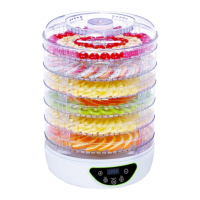12
Drying Vegetables
Some vegetables are quite good dried. Others lose their appeal and are better frozen or fresh. Some
vegetables are far better frozen than dried, if you must preserve them. Vegetables have a low acid and
sugar content that makes them more subject to spoilage, and tend to have far shorter shelf life than dried
fruits.
Choose fresh, crisp vegetables for a high quality dehydrated product. Just like fruits, vegetables should be
picked ripe and dried as soon as possible to minimize loss. Wash vegetables thoroughly and remove any
blemishes. Peel, trim, core, slice or grate.
Most vegetables must be blanched, either steaming over boiling water or in the microwave oven to slow
the enzyme action which will continue during drying and conditions are key elements to producing dried
vegetables which will taste as good in winter as the summer product.
There is no need to blanch onions, garlic, peppers, and mushrooms. Herbs also are not to be blanched.
Blanching
Bring about 1 inch of water to a brisk boil and drop in sliced or grated vegetables. Cover. Steam until
vegetables are heated completely through, but not cooked. This is usually about 1/3 of the time required
to cook the vegetable. Vegetables should still be crunchy. Drain and then dip them in cold or iced water
for 3-5 minutes. Start dehydrating immediately after blanching.
Microwave Blanching
A microwave oven is ideal for blanching vegetables. Prepare them in the same manner as for steam
blanching. Place them in a microwave-safe dish with 3 table spoons of water at the bottom, cover and
cook on high for about 1/2 of the time required to completely cook the fresh vegetable. Depending on the
age and design of your microwave, you may want to stop the cooking half-way through and stir the

